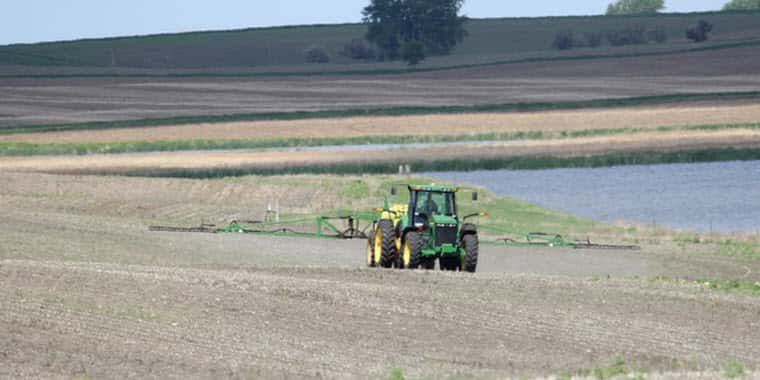Report Implicates Glyphosate
Herbicide Called Probable Carcinogen
by Pam Smith, Crops Technology Editor
DECATUR, Ill. (DTN) — Glyphosate, one of the world's most popular herbicides, has been labeled as a probable carcinogen by the International Agency for Research on Cancer (IARC). The France-based research arm of the World Health Organization published the assessment Friday with a summary which also considered the status of four organophosphate insecticides.
Response from the agriculture community was swift. The Joint Glyphosate Task Force, a group of more than 20 members holding glyphosate registrations in the United States and Canada, requested that IARC immediately meet with global regulatory authorities to disclose what studies IARC did or did not consider in making its decision. “The conclusion reached is not consistent with scientific studies that have been conducted over more than 40 years,” the group stated in a press release.
Glyphosate came to market in 1974 and was developed by Monsanto and first sold under the Roundup label for control of perennial and annual weeds in non-crop and industrial areas. Agricultural crops genetically engineered to withstand glyphosate have greatly expanded the use of the chemistry since 1996. Glyphosate is also used in forestry, urban and lawn and garden applications.
The French agency classifies four levels of risk for possible cancer-causing agents: known carcinogens, probable or possible carcinogens, not classifiable and probably not carcinogenic. IARC classified glyphosate with a 2A rating — meaning it is “probably carcinogenic to humans.” The insecticides malathion and diazinon were also classified as 2A.
The pesticides tetrachlorvinphos and parathion were classified as “possibly carcinogenic to humans,” or Group 2B. This assessment means there “is convincing evidence that the agent causes cancer in experimental animals, but little or no information about whether it causes cancer in humans.”
Monsanto told DTN by email that the announcement was “disappointing.”
In a public statement, Philip Miller, Monsanto vice president for global regulatory affairs, noted that as recently as January 2015, the German government completed a rigorous, four-year evaluation of glyphosate for the European Union. “They reviewed all the data IARC considered, plus significantly more, and concluded 'glyphosate was unlikely to pose a carcinogenic risk in humans.'
“We join fellow members of both the EU and U.S. glyphosate taskforces in our disagreement with this classification for several reasons: There is no new research or data that was used; the most relevant, scientific data was excluded from review; the conclusion is not supported by scientific data; and there is no link between glyphosate and an increase in cancer when the full data set is included in a rigorous review,” Miller said.
IARC's statement said the scientific evaluation was based on a comprehensive review of scientific literature. “But it remains the responsibility of individual governments and other international organizations to recommend regulations, legislation or public health intervention,” they noted.
The U.S. Environmental Protection Agency responded to the report by noting that the agency's most recent human health risk assessment of glyphosate (2012) concluded that when used according to the EPA-approved label directions, the pesticide meets the statutory safety standards.
The following statement was issued in response to the IARC report: “The EPA is currently reassessing glyphosate as part of its scheduled registration review (the periodic re-evaluation required by FIFRA every 15 years) and coordinating its re-evaluation with Canada's Pest Management Regulatory Agency. During registration review, the EPA will update the existing human health and ecological risk assessments based on the best available scientific data. We will determine whether any risk mitigation is needed to ensure that glyphosate can continue to be used without unreasonable risks to people or the environment, including species like the monarch butterfly. We expect to release for public comment the preliminary ecological and human health risk assessments for glyphosate later in 2015. If at any time EPA discovers that the use of a registered pesticide may result in unreasonable adverse effects on people or the environment, we will take action to remove it from the marketplace or limit its use.”
IARC critic and long-time ag chemical industry leader Val Giddings said the agency appears to have considered reports such as the 2012 rat study by Gilles-Eric Seralini. That study, which included feeding laboratory rates glyphosate-contaminated feed and corn from glyphosate-resistant plants, produced a group of photos of tumor-laden rats that quickly made the rounds in Internet chat rooms and various websites hosted by those who oppose genetically engineered crops. Seralini's study was quickly denounced as lacking scientific credibility by most of the world scientific community.
“If you favorably cite the 2012 Seralini rats fed on Roundup Ready maize study, you just lost the argument,” Giddings said, quoting the so-called “Seralini rule.” “The fact that IARC seems to be taking seriously this laughingstock publication suggests they have run thoroughly off the rails, gone beyond anything defensible as science, and well into fictional realms.”
To read the IARC evaluation of five organophosphate insecticides and glyphosate, go to: http://www.iarc.fr/…
A link to excerpts from the decisions of several regulatory agencies regarding glyphosate and cancer: http://www.monsanto.com/…
© Copyright 2015 DTN/The Progressive Farmer. All rights reserved.




